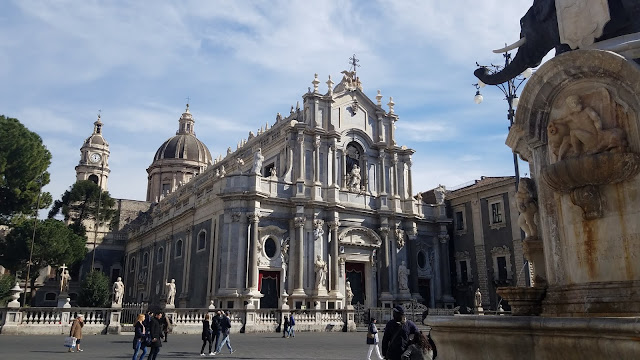 |
| Catania is the second largest city in Sicily. |
 |
| Mount Etna towers over Catania to the North. The city has suffered from multiple volcanic eruptions and earthquakes. Some days we saw smoke snaking out of the top of the volcano. |
 |
| Catania's local museum is housed in Castello Ursino. It was built in the 13th century by Emperor Frederick II, King of Sicily, Germany, Italy, and Jerusalem. |
 |
| Ancient Greeks founded Catania in the 700s BC. |
 |
| Later Carthaginians and Romans ruled Catania. It had a large population of Jews during Roman rule. |
 |
| St. Agatha is the patron of Catania. |
 |
| The Hashish Effect, 1875 |
 |
| This activates when you walk in front of it... not my favorite experience ever. |
 |
| Le donne don't want the boys on the front to forget them. |
 |
| Catania experienced the heaviest bombing of any city on Sicily during World War II. Many new buildings have sprung from the foundations of the old. |
 |
| A fairly disturbing war memorial |
 |
| Roman ruins are scattered through Catania. The Terme dell' Indirizzo is one of many ancient baths of Catania. |
 |
| The Odeon |
 |
| Another terme |
 |
| Catania's amphitheater was the largest in Sicily. |
 |
| A fountain next to the train station |
 |
| Catania's famous Baroque church, overlooked by u Liotru, the elephant mascot of Catania, made in the 1700s. |
 |
| There are many legends about the magical elephant and its ability to sense Etna's eruptions. |
 |
| Catania, and southeastern Sicily in general, is covered with orange trees. |
 |
| The fascist aesthetic is still visible in Catania. |
 |
| They really should get rid of the Fasces. |
 |
| Don't worry, there are designer pet clothing stores in Catania too. |
 |
| The monastery survived earthquakes and lava over its 500 year life, but the monks could not survive Italian reunification. The new Italian state confiscated the monastery in 1866. |
 |
| There are Roman ruins in the library of the building. |
 |
| A huge lava bench had to be incorporated in the complex after a volcanic eruption in 1669. |
 |
| Catania is home to many excellent restaurants. Scirocco Sicilian Fish Lab has great cheap seafood. |
 |
| You can eat in a cave with an underground river at A Putia Dell' Ostello! |


No comments:
Post a Comment